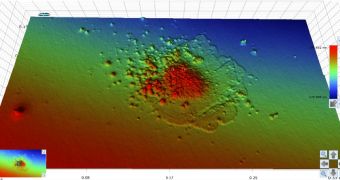A group of investigators at the European Space Research and Technology Center (ESTEC), in Noordwijk, the Netherlands, announce the development of a new microscopic optical technique that can resolve details as small as a nanometer on various surfaces.
ESTEC is the main technology development and test center the European Space Agency (ESA) operates for spacecraft and space technology. The optics laboratory at ESTEC is responsible for the new advancement, which comes with a host of groundbreaking applications in microscopic imaging.
The image attached to this article was snapped using the new technique. It reveals how contamination produced by lasers affects surfaces that are otherwise nearly perfectly flat. In this particular case, the surface is actually a laser lens that has been used consistently before being discarded.
Interestingly, the method developed at the ESTEC optics lab can map out these nanoscale irregularities in just a few seconds. This implies that fast-paced practical applications are possible. With other techniques, obtaining results can take hours to days, making them unsuitable for such uses.
The new method is basically a high-tech version of “spot the difference.” Two laser beams are used for the imaging process. The first shines directly on the target being mapped, while the second bounces off a near-perfect mirror located under the sample.
Complex algorithms then analyze the tiny differences between the two laser beams, and produce contour lines of sorts that can then be worked into usable images. The software that comes with the new approach can also be used to create panorama images very quickly.
The hardware device ESTEC engineers work with is called a white-light interferometric microscope, and is generally used to assess any potential damages to laser lenses after numerous test firings of high-powered lasers.
ESA scientists say that techniques such as this one will be very important as space exploration moves from using radio wavelengths to using laser light in space-to-space communications. Future missions scattered throughout the solar system will have to feature lasers that can work flawlessly over many years.

 14 DAY TRIAL //
14 DAY TRIAL //